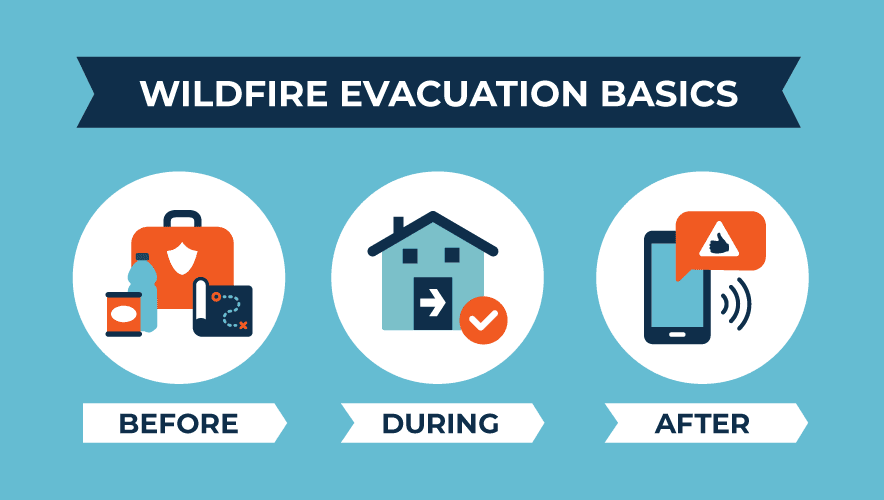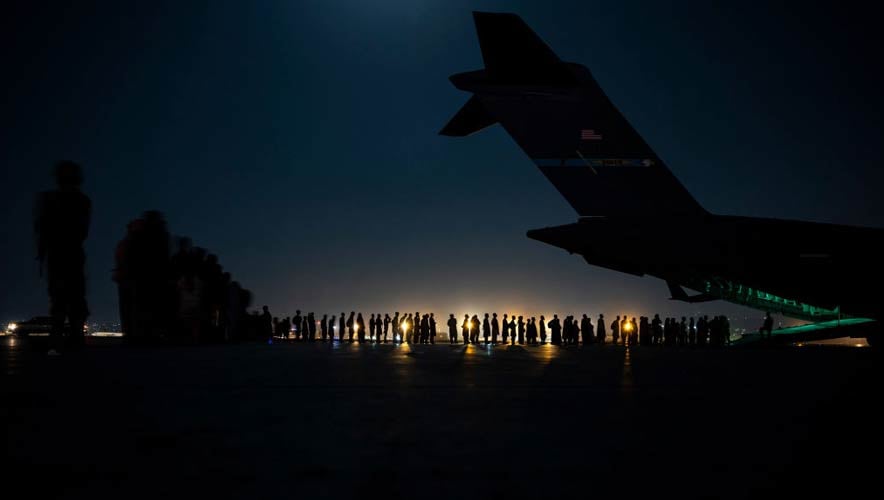Before, During, and After: Wildfire Evacuation Basics
Heatwaves and unrelenting droughts created the perfect fire starter to ignite wildfire season in 2022. Millions of acres burned, and tens of thousands of people were forced to evacuate their homes, businesses, and communities to flee from danger.
“Fires are burning faster and hotter than ever before, and complex socio-economic factors result in more people being affected by smoke, debris flows, and other wildfire effects,” according to the Center for Disaster Philanthropy. “It is becoming more common for areas to suffer a subsequent catastrophic wildfire before recovering from an earlier wildfire.”
To be better prepared for the 2023 wildfire season in your area, here’s a list of actions to take before, during, and after evacuating.
![]() In your vehicle, keep the fuel tank at least half full and store a flashlight, portable radio, and first aid kit inside.
In your vehicle, keep the fuel tank at least half full and store a flashlight, portable radio, and first aid kit inside.
![]() Designate a neighbor or friend who might assist you by loading or driving a second vehicle during an evacuation.
Designate a neighbor or friend who might assist you by loading or driving a second vehicle during an evacuation.
![]() Have nonperishable food items (such as snacks) and one gallon of water per person on hand and ready to transport.
Have nonperishable food items (such as snacks) and one gallon of water per person on hand and ready to transport.
![]() For pet owners, keep carriers, food bowls, food, litterboxes, litter, and other needs in a staged area so they can easily be loaded into a vehicle.
For pet owners, keep carriers, food bowls, food, litterboxes, litter, and other needs in a staged area so they can easily be loaded into a vehicle.![]() Create a documents box that includes backups of important files, insurance policies, life and investment files, bank records, legal documents, and a list of phone numbers and addresses of family and neighbors.
Create a documents box that includes backups of important files, insurance policies, life and investment files, bank records, legal documents, and a list of phone numbers and addresses of family and neighbors.
![]() Create a sentimental items box for photograph albums and mementos.
Create a sentimental items box for photograph albums and mementos.
![]() Pack a suitcase with a few changes of clothes and extra shoes, as well as toiletry items and medication to last several days.
Pack a suitcase with a few changes of clothes and extra shoes, as well as toiletry items and medication to last several days.
![]() If possible, gather camping equipment—sleeping bags, pillows, water bottles—to be used if you need to sleep outdoors as part of the evacuation process.
If possible, gather camping equipment—sleeping bags, pillows, water bottles—to be used if you need to sleep outdoors as part of the evacuation process.![]() Plan several escape routes from your home.
Plan several escape routes from your home.
![]() Draft an email to friends, colleagues, and family members detailing your evacuation plan and designated emergency meeting location outside the fire area.
Draft an email to friends, colleagues, and family members detailing your evacuation plan and designated emergency meeting location outside the fire area.
![]() Put on sturdy shoes and clothing that provides some protection (long pants and long-sleeved shirts).
Put on sturdy shoes and clothing that provides some protection (long pants and long-sleeved shirts).
![]() Load all staged items from the above list into your vehicle.
Load all staged items from the above list into your vehicle.
![]() Close all windows and interior doors of your home, but do not lock them so firefighters can gain access.
Close all windows and interior doors of your home, but do not lock them so firefighters can gain access.
![]() Unplug electrical equipment, except for freezers and refrigerators.
Unplug electrical equipment, except for freezers and refrigerators.
![]() Remove curtains from all window areas.
Remove curtains from all window areas.
![]() Move flammable furniture to the center of rooms, away from doors and windows.
Move flammable furniture to the center of rooms, away from doors and windows.
![]() Shut off gas at meters and turn off all pilot lights.
Shut off gas at meters and turn off all pilot lights.
![]() Turn on lights in your home so it is visible in smoky conditions.
Turn on lights in your home so it is visible in smoky conditions.
![]() Shut off air conditioning.
Shut off air conditioning.
![]() Remove grill propane tanks and place them away from your home or load them into your vehicle.
Remove grill propane tanks and place them away from your home or load them into your vehicle.
![]() Connect outdoor hoses to water valves or spigots for firefighters to use.
Connect outdoor hoses to water valves or spigots for firefighters to use.
![]() Ensure you have copies of all keys (house and car keys), plus wallets, cell phones, and personal identification on your person or in your vehicle.
Ensure you have copies of all keys (house and car keys), plus wallets, cell phones, and personal identification on your person or in your vehicle.![]() Collect your pets and secure them so they cannot escape while putting them into a vehicle (especially important for cats).
Collect your pets and secure them so they cannot escape while putting them into a vehicle (especially important for cats).
![]() Send your pre-drafted email.
Send your pre-drafted email.
![]() Follow the recommended evacuation route to leave your home.
Follow the recommended evacuation route to leave your home.
![]() Only prepare to return to your home or office after receiving an all-clear from authorities.
Only prepare to return to your home or office after receiving an all-clear from authorities.
![]() Let friends, family, and colleagues know your plan to return home and provide them with updates on your progress.
Let friends, family, and colleagues know your plan to return home and provide them with updates on your progress.
![]() Charge your devices and take charged backup batteries with you.
Charge your devices and take charged backup batteries with you.![]() Take food supplies and water with you.
Take food supplies and water with you.
![]() Only use a generator outside and away from your home.
Only use a generator outside and away from your home.
Sources: Cal Fire, The U.S. Forest Service, and the U.S. Department of Homeland Safety.












